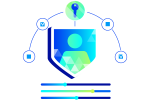What is cloud security?
In the digital age, cloud security has become a priority for all businesses. With the increasing adoption of cloud services and data storage infrastructure, it’s crucial to protect these resources and applications from persistent threats. Learn how effective security solutions protect information, increase customer trust, and ensure strict compliance in an ever-changing IT environment.

Cloud security definition
Cloud security is the set of measures, practices and technologies designed to ensure the protection of data, applications and infrastructure within cloud computing environments, whether they are IaaS, PaaS or SaaS services. It aims to prevent unauthorized access, detect and respond to security incidents, and ensure strict compliance with regulations.
Unlike traditional data security, which is often centered on an organization’s internal systems and local servers, cloud security needs to be tailored to a shared, flexible, and dynamic environment. Organizations must manage various risks, such as denial-of-service (DDoS) attacks, data breaches, and API vulnerabilities, while ensuring the confidentiality, integrity, and availability of information and resources. A cloud security solution also relies on the effective allocation of shared responsibilities between users, customers, and cloud service providers. This is to maintain complete visibility across all systems and the network.
Why is cloud security important?
Cloud security is crucial, as it protects sensitive data, critical applications and critical business services from a variety of risks and threats.
Targeted cyberattacks
Cloud computing environments are a prime target for cybercriminals. They use ransomware, DDoS attacks, and other sophisticated techniques to infiltrate systems and compromise data and infrastructure security.
Configuration errors
The complexity of cloud environments and shared infrastructure can lead to unintended errors that expose sensitive information. For example, misconfiguring access to a data warehouse can allow unauthorized users to access confidential data, putting the organization’s IT resources at risk.
Regulatory non-compliance
Insufficient security can lead to breaches of data protection regulations, resulting in financial penalties and damage to the organization’s reputation.
Poor security in the cloud can have many serious consequences.
Financial losses
Security breaches can result in high costs related to downtime, regulatory fines, and repairing system and application damage.
Damage to reputation
A successful data breach or cyberattack can seriously damage a company’s reputation, affecting its relationship with customers and partners.
Loss of customer and user trust
Security incidents can erode customers’ and users’ trust in the cloud services provided, which can lead to lower loyalty and revenue.
For these reasons, it is essential to take a proactive approach to cloud security, implementing robust solutions to protect resources and maintain customer and user trust, while ensuring visibility and control across all systems and the network.
The advantages of cloud security
Adopting security solutions adapted for the cloud offers many benefits for companies and organizations. First, effective cloud security protects against evolving threats, such as cyber-attacks, data breaches, and information leaks, ensuring the confidentiality, integrity, and availability of data and applications. It also delivers optimal asset management by enabling continuous monitoring of cloud environments and proactive detection of potential vulnerabilities within systems and networks.
Cloud security also allows businesses to maintain compliance with international standards and regulations, reducing the risk of penalties and building customer and user trust. And it offers great flexibility, as cloud security solutions are often scalable and adapt to organizations’ changing needs. This is true regardless of their infrastructure model or size.
Finally, cloud security offers significant cost savings by reducing the cost of protecting IT infrastructure on-premises or in a private datacentre, while providing superior protection through advanced technologies such as encryption, automated access controls, and centralized systems and network administration. It also provides greater visibility of activities and responsiveness to potential threats, enabling more secure and efficient work for all stakeholders.
To learn more, check out our case studies that illustrate the importance of cloud security:
How do I keep the cloud secure?
To ensure optimal security in a cloud environment, it is essential to implement strategic measures that are tailored to each deployment model, and follow proven cybersecurity practices. These actions help protect data, applications and services from cyber threats, while ensuring regulatory compliance and building customer trust.
Access controls and identity management
Access controls and identity management are crucial to securing cloud environments. By restricting access to authorized users and devices only, through methods such as multi-factor authentication (MFA), identity and access management (IAM), and lower privilege policies, organizations can significantly reduce the risk of security breaches. These measures also improve the visibility and fine-grained management of user access rights.
Data encryption
Encryption is fundamental to protecting data in the cloud. It ensures that information remains unreadable to any unauthorized person, whether the data is in transit or at rest. It ensures data confidentiality and integrity, even in the event of unauthorized access or theft, so effective encryption key management is a critical parameter in ensuring that only authorized people can access sensitive information.
Security monitoring and auditing
To quickly identify and respond to potential threats, continuous monitoring and regular security audits are essential. These actions can detect abnormal behaviors, identify vulnerabilities and evaluate the effectiveness of the security measures put in place. By using real-time monitoring tools and conducting regular audits, companies can ensure their security practices are up to standard and able to prevent or mitigate incidents before they cause significant harm.
Incident and response management
A robust incident and response management strategy minimizes the impact of IT security breaches. This includes putting in place action plans to quickly detect, contain, and resolve security incidents, clear communication between teams, and rapid root-cause analysis to restore affected services. All of these measures, effectively applied, strengthen the company’s resilience to future threats.
Implement robust security policies
Defining strong security policies is a key step to securing the cloud. This includes the use of multi-factor authentication (MFA), strict identity and access management, as well as rules for storing and processing data that comply with international standards (e.g. GDPR or ISO 27001). Security policies should also cover incident management, responses to cyber-attacks, and ongoing employee training in security best practices.
Choosing a secure cloud provider
Selecting a cloud service provider with advanced security features is obviously crucial to protecting the cloud environment. This makes it vital to choose a provider that offers granular access controls, in-transit and at-rest data encryption, and continuous monitoring to detect suspicious behavior. Compliance with international security standards (ISO 27001, SOC 2, PCI DSS) and the ability to effectively handle security incidents should also be ensured.
Today’s Cloud Security Challenges
As organizations transition to cloud environments, they must address a range of security challenges, from the increasing complexity of architectures, to the diversity of services on offer, to rapidly evolving cybersecurity threats.
Complexity of multi-cloud integration and hybridization
Utilizing a multi-cloud model, or a hybrid architecture combining public and private cloud infrastructure, poses unique security challenges. Each cloud platform can have its own standards, security configurations and data management practices, which can lead to inconsistencies and gaps in organizations’ security policies. Effective integration requires ensuring that all platforms and environments are compliant with security requirements, offering uniform visibility and control across the entire cloud infrastructure. Businesses should adopt cloud solutions and security tools that can operate in multi-cloud environments, ensuring asset protection and service continuity while minimizing risk. Centralized systems management and proactive network monitoring are key to maintaining a robust security posture in a multi-cloud or hybrid environment. Furthermore, implementing security practices that are tailored to each cloud provider is necessary to ensure a harmonized, effective defense.
Internal threats and human error
Insider threats, such as malicious employee actions or unintentional human error, pose a major challenge to cloud security. Misconfiguration of cloud services, use of weak passwords, or accidental disclosure of sensitive information can expose critical data to security risks. To mitigate these threats, robust Identity and Access Management (IAM) policies, stronger access controls, and a culture of security through ongoing employee training are crucial. Using automation tools for configuration control and analysis of user behaviors can also help detect and prevent potentially harmful actions. By adopting an integrated security solution, organizations can ensure more effective protection of assets and maintain visibility across systems and networks. It’s also important to work with cloud providers to benefit from advanced security tools and practices that reduce the likelihood of human error and minimize insider threats.
Rapidly evolving cybersecurity threats
Cyber security threats are evolving at a high rate, with new vulnerabilities discovered every day and increasingly sophisticated hacking techniques. Cyber attackers use artificial intelligence tools, malware and automated attacks to target cloud environments and exploit vulnerabilities. In the face of this rapid evolution, organizations and organizations must take a proactive approach to security, including continuous system monitoring, user behavioral analysis, and rapid incident response. Regular audits, penetration testing, and frequent security software updates are also essential to maintain a high level of protection against these threats. Furthermore, it is crucial to work closely with cloud providers to put in place robust security solutions that ensure data, application and resource protection across all environments, while ensuring full visibility into the infrastructure as a whole.
Compliance with international regulations
Ensuring compliance with various data protection regulations, such as the GDPR in Europe, the CCPA in California, or other international security standards, represents a major challenge for companies operating in international cloud environments. Regulations vary greatly from region to region, making it difficult to meet all requirements. To ensure compliance, it is essential to gain a deep understanding of local laws and continually adapt security policies to meet new requirements in the cloud computing arena. This includes rigorous data administration, strict access control, secure information storage, and the ability to react quickly to regulatory changes. Working with cloud service providers that offer solutions that are compliant with international standards can facilitate this, while ensuring adequate data protection and efficient processing of resources and systems. Regular audits and internal controls also help maintain a high level of compliance and minimize the risks associated with regulatory violations.
OVHcloud and its solutions for cloud security
At OVHcloud, we understand the crucial importance of protecting your data and applications in the cloud. Our robust and scalable security solutions enable you to enhance your security while harnessing the flexibility and performance offered by our cloud services. Find out how our specialized tools can help you secure your cloud environment in an efficient, industry-best-practice way.

Identity and Access Management
With our Identity and Access Management (IAM) solution, you can securely and centrally manage identities and access to your cloud resources. With advanced features such as role-based access control (RBAC), multi-factor authentication (MFA), and fine-grained permission management, you can ensure that only authorized users can access your sensitive data. This solution strengthens security while simplifying access management within your organization.

Key Management Service
Our Key Management Service (KMS) offers you comprehensive and secure management of the encryption keys used to protect your sensitive data. With features such as secure storage and key lifecycle management, along with strict compliance with international security standards, this solution ensures optimal data protection while meeting local regulatory requirements.

OVHcloud Anti-DDoS
Our Anti-DDoS solution offers robust, automated protection against distributed denial-of-service attacks, ensuring the continuous availability of your online infrastructure. With real-time detection and intelligent traffic filtering, OVHcloud Anti-DDoS can counter attacks of any size or complexity, while minimizing the impact on service performance. This protection is included by default in all OVHcloud solutions, to secure your resources and ensure business continuity.


